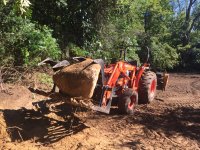You are using an out of date browser. It may not display this or other websites correctly.
You should upgrade or use an alternative browser.
You should upgrade or use an alternative browser.
Grappling fun - A Picture Thread....
- Thread starter Piston
- Start date
- Views: 675271
More options
Who Replied?
/ Grappling fun - A Picture Thread....
#641
4570Man
Super Star Member
- Joined
- Apr 7, 2015
- Messages
- 18,936
- Location
- Crossville, TN
- Tractor
- Kubota M59, Kubota L3800, Grasshopper 428D, Topkick dump truck, 3500 dump truck, 10 ton trailer, more lighter trailers.
Not after they have sunken up to the axel.You can get better traction with narrow tires.
IslandTractor
Super Star Member
- Joined
- Sep 15, 2005
- Messages
- 16,647
- Location
- Prudence Island, RI
- Tractor
- 2007 Kioti DK40se HST, Woods BH
You can get better traction with narrow tires.
In snow that is true for cars but I cannot see how that would be true on a tractor in a field. Explanation???
TomSeller
Super Member
In snow that is true for cars but I cannot see how that would be true on a tractor in a field. Explanation???
Snow and cow poop have a lot in common.
My soils tend to have clay in it up high heavily supplemented by bovine fertilizer. My wider tires tend to spin and stay high at which time I have to go back to the barn to trade tractors. My narrower deeper lug tires tend to dig through the poop and clay and get down to firmer soil and get traction when feeding the herd. Hence my comment that narrow tires "can" (read:may not always) provide more traction. As always, individual situations and traction may vary.
Jim Timber
Veteran Member
In snow that is true for cars but I cannot see how that would be true on a tractor in a field. Explanation???
Ground pressure. The skinny tires have higher pounds per square inch of contact than a larger one. Same weight, applied over more surface area = lower force.
IslandTractor
Super Star Member
- Joined
- Sep 15, 2005
- Messages
- 16,647
- Location
- Prudence Island, RI
- Tractor
- 2007 Kioti DK40se HST, Woods BH
Snow and cow poop have a lot in common.
My soils tend to have clay in it up high heavily supplemented by bovine fertilizer. My wider tires tend to spin and stay high at which time I have to go back to the barn to trade tractors. My narrower deeper lug tires tend to dig through the poop and clay and get down to firmer soil and get traction when feeding the herd. Hence my comment that narrow tires "can" (read:may not always) provide more traction. As always, individual situations and traction may vary.
Yes but is it the narrower tire or the deep R1 lugs that help more with traction? If you took two R4 tires of different widths, which would have more traction? I'd think that the wider would. Snow is a special case as narrow tires cut through the snow to make contact with the pavement below rather than riding on top but I don't think that would be particularly relevant in a farm/field situation (without snow).
IslandTractor
Super Star Member
- Joined
- Sep 15, 2005
- Messages
- 16,647
- Location
- Prudence Island, RI
- Tractor
- 2007 Kioti DK40se HST, Woods BH
Ground pressure. The skinny tires have higher pounds per square inch of contact than a larger one. Same weight, applied over more surface area = lower force.
Yes, lower force/weight per square inch of tire contact with larger tires. But, more surface area in contact so more friction which presumably translates to better traction. Why do dragsters have big fat tires instead of narrow tires on the drive wheels?
Jim Timber
Veteran Member
Yes, lower force/weight per square inch of tire contact with larger tires. But, more surface area in contact so more friction which presumably translates to better traction. Why do dragsters have big fat tires instead of narrow tires on the drive wheels?
Because they need more surface area to keep from spinning too much and they can't be heavier without taking a penalty in acceleration. Those tires are also set to very low psi so the sidewalls flex. It's not an apples to apples comparison.
When you increase footprint, you do it so you can apply more power to the surface of ground, not so you can cut deeper into it. Snow doesn't translate force like dirt does. You want to sink down through it so you can get to hard earth and skinny tires get you there. Same with mud. Skinny mud tires are designed to excavate the path of the tire to solid dirt at the bottom.
TomSeller
Super Member
You want to sink down through it so you can get to hard earth and skinny tires get you there. Same with mud. Skinny mud tires are designed to excavate the path of the tire to solid dirt at the bottom.
Yep, that is what I am seeing. They cut through the cow carp and get to firm soil.
Piston
Elite Member
This "Grapple Picture Thread" has derailed.
Let's try to get back on topic fellas, there are plenty of discussions about tires elsewhere on the forum.
(Or, if you just HAVE to have these discussions, at least post a photo with every off topic reply )
)
More pics please.
Let's try to get back on topic fellas, there are plenty of discussions about tires elsewhere on the forum.
(Or, if you just HAVE to have these discussions, at least post a photo with every off topic reply
More pics please.

